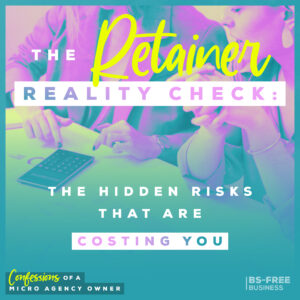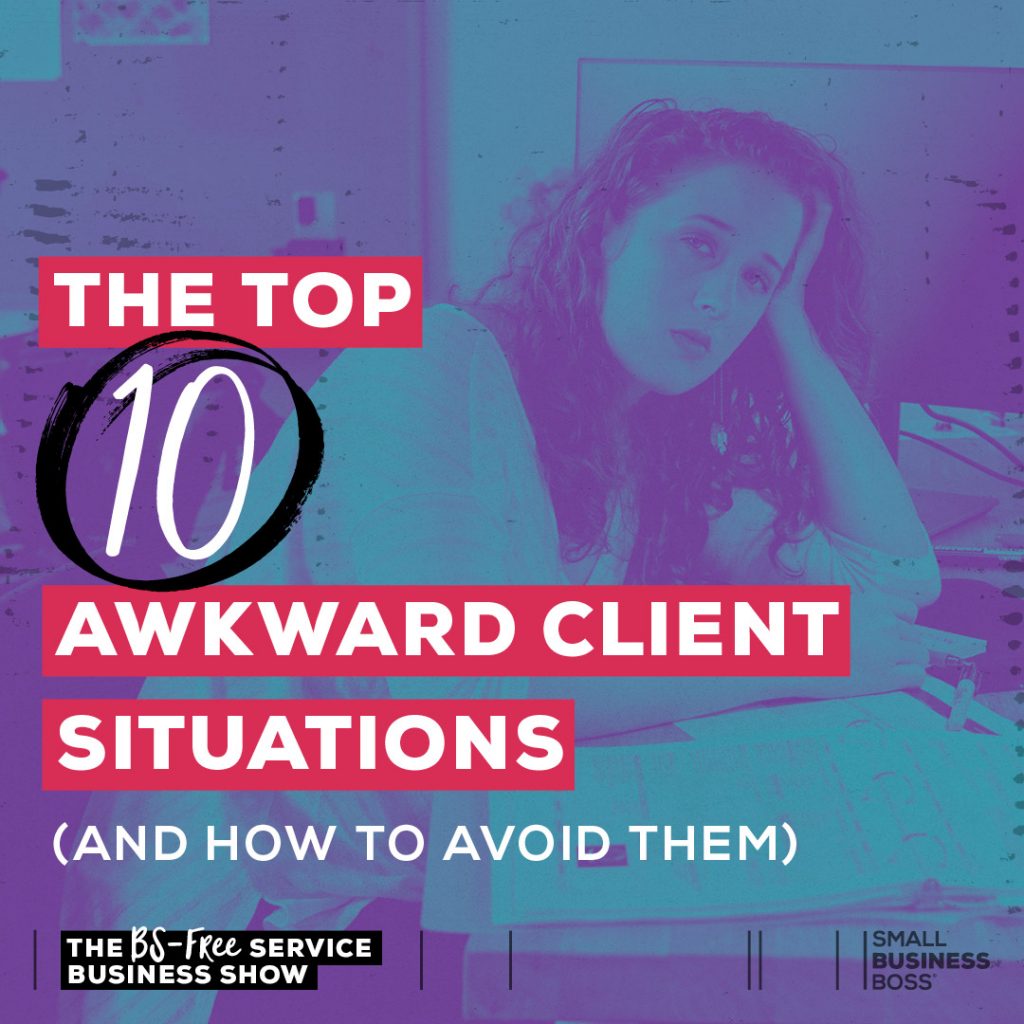
Search the site:
The Top 10 Awkward Client Moments (and How to Avoid Them)
We’ve all had those moments. The moments where things just got super awkward with a client, and you’re ready to crawl into a hole. While you can’t avoid them completely, there are some things you can do to make awkward client moments happen way less often.
In this episode, we’re digging into the top 10 awkward client moments and how to hopefully avoid them.
As we talked about in the last episode, awkward client moments are totally a thing. They’re bound to happen from time to time, so the goal should be to do what we can to ensure they’re few and far between.
There are really two aspects to this. First off, I want you to know that those awkward client moments are just a fact of working with clients. So when they happen (notice I didn’t say if), please be kind to yourself. Nobody is perfect, and we’ve all got lives, emotions and so much more contributing to how we feel and react in these moments.
In short, you’re not a robot, so if you feel awkward or exasperated, or irritated, it is normal. Guess what? You’re totally human.
The second part of it is that there are definitely situations that we can take steps to avoid. Think of this as having a plan for how to mitigate the risk of them happening, because while they still may pop up, they’re less likely to derail us as we know we’ve done our best to address them.
When we’re proactive about stopping these situations before they start, we’re likely going to have fewer of them overall. Plus, by focusing on avoiding those awkward client moments where we can, we have a golden opportunity to turn them into awesome moments for our clients.
Those awesome moments are what set us apart as service providers. They’re what turns you into a referred and preferred service provider. And that’s exactly why they matter more than we may realize.
Not only do they make your life easier, but they also make a positive contribution to your reputation and relationships.
Now before we dive into the top 10 awkward client moments, and my suggestions on how to avoid them, I want to quickly address one quick thing.
These moments are not about villainizing or complaining about clients. I’m all about having respect for your clients, and not talking trash about them. That said, these situations do happen, and I’m not going to go all toxically positive on you and sugarcoat it.
Just know, this may be a little irreverent, but I also hold deep respect for my clients and encourage you to do the same. (And if you don’t respect your clients, that’s a conversation we need to have later on!)
Table of Contents
#1: Bad Fit or Obnoxious Potential Client
Let’s start with a moment that pops up before someone is a client, but it’s no less awkward. It’s that moment when you’re excited about a new lead, and things start to go off the rails.
You realize they’re a bad fit for your services. Or you engage with them and they’re pushy. Or worst yet, you’re on the consult call, and it’s beyond awkward and you know this isn’t a client you want.
Now, the obvious thing here is that you need to extricate yourself from the situation, but the bigger question becomes how to stop these clients from getting through your door in the first place.
Avoiding the Awkward:
- Look at where this client came from. Often, these clients are referrals, so watch for a pattern as you may have a referral source sending you all the wrong potential clients. That’s an opportunity for you to do a better job of being proactive about your referrals and working to ensure the right people are referred to you.
- What’s your consult call process look like? How are you screening people to get on that call? There are a lot of things you can do to avoid talking to people who aren’t a fit before you get into a situation where you’re having to say no on Zoom. How can you screen for fit with your services page? Your request for a consult form? Do you have any follow-up questions?
#2: Consult Call That Goes Completely Off the Rails
Listen, I’m someone who really misses the days when a call didn’t have a video component. Especially for an intro or consult call with a potential new client, as holy awkward at times.
Especially as there’s always the potential for things to go off the rails. Sometimes a client is asking for way too much input before we even know if we’re working together. Or they start a rapid-fire series of questions or want you to prove yourself.
Avoiding the Awkward:
- Have a clear process for your consult calls and screen people for fit before they get on a call.
- Take control of the agenda immediately on consult calls to set expectations. Articulate what you’ll talk about and the structure for the call. Don’t just let them ramble or ask for free advice.
#3: The Client Asks You the Price
Money is often uncomfortable for us to talk about, and we can feel really freakin’ awkward when someone asks the dreaded “how much will this cost?” question.
Let’s be real, if you offer consulting or creative done-for-you services, this question may require some thought. Hell, it may require some math for you to figure out what’s required for the engagement.
This is one reason I’m a big fan of packaging your services, so you at least have a clear baseline of the pricing and aren’t making it up on the fly.
Avoiding the Awkward:
- Nail down set packages with defined deliverables, and use a set process with your clients. When you can articulate that and the value you bring, you’ll be that much more confident when answering the question of price.
- Invest time in your pricing strategy. Figure out all the inputs it takes for you to deliver a service, and what that really needs to cost.
- Finally, if you can’t provide a price, that’s totally okay. Feel free to decline pricing questions if you need to go away and think about it. It’s as easy as saying, this is nuanced and I want to ensure I can give you an accurate price.
#4: You Send a Proposal and the Client is MIA
Honestly, this next one is one of the most baffling ones to me. If I invest time getting on a call with you and asking for a proposal, we’re probably 90% of the way to a yes. So when I send a proposal and then never get anything back, it’s a bit of a mystery to me.
This one is a special kind of awkward, especially if you have great chemistry on your consult call and you’re excited about the opportunity. And then crickets once the proposal lands in their inbox.
Avoiding the Awkward:
- One of the big reasons that this happens is that people aren’t really ready for a proposal. This is why I like to ask permission to send a proposal, and if we haven’t talked budget to feel out the general budget ballpark. If they’re unsure about the budget or hesitate, that’s a sign that they may not be ready.
- Invest time in your proposals. Ensure it does everything possible to make your potential client feel like they can trust you and that you’re a great fit. So many proposals die because they’re incomplete and simply don’t do a good job of closing the deal.
- Finally, have a plan for your follow-up. A little bit of persistence to check in and ensure things didn’t go missing or get forgotten will go a long way. I have a series of three scripts I use for proposal follow-up so it’s not just, “do you have an answer” which is super awkward. I’ve had potential clients thank me not just for following up but for doing it in a way that adds value.
#5: Where’s My Money?
Nothing makes me feel more awkward than people not paying me on time. Maybe that’s because like most of us, I come up with countless reasons why the invoice hasn’t yet been paid.
When the truth is usually that it has nothing to do with me, and everything to do with internal processes or people just not feeling the same urgency I do. And because I don’t want to have to blast a certain Rhianna song about having my money, I’ve had to learn how to communicate differently around it.
Avoiding the Awkward:
- Get paid upfront. It’s way less awkward if you’ve not started work yet and it’s been communicated that you need payment to start work. Make that clear in your proposals, your contracts, and your onboarding. I recommend that your onboarding process is built so that invoices don’t get lost or overlooked. (For my corporate clients I like to ask who the accounts payable contact is.)
- Have processes in place for follow-up. If you bill net 15 or 30, have reminders to ensure that you follow up on the due date. Don’t let that slide by.
- Create scripts for yourself so you can remove the emotion from it. I have a series of scripts I use that are factual and keep me from sending them a Rhinana GIF of said song.
#6: You’re Going to Miss a Deadline
If you work as a creative or consultant, you’re likely dealing with deliverables and deadlines. They’re part of your day-to-day reality, but those deadlines, sometimes they’re just not going to happen.
Missed deadlines happen. But how you handle them determines if it’s about to get awkward or not.
Avoiding the Awkward:
- Button up your project management processes. So many times missed or slipped deadlines are the result of project management getting sloppy.
- Stop saying yes to unrealistic client deadlines. Offer alternatives so that you’re not saying no, but you’re not ending up in an unworkable situation.
- Stop creating artificial deadlines that your client doesn’t care about. Do you know how many times I’ve sent something to meet a deadline and the client didn’t look at it for a week? So many! Ask questions about the timeline to determine the real deadline. The question “when do you need this by” will work wonders.
- Finally, if it’s unavoidable, inform the client before it’s too late. What’s really awkward is when you blow by the deadline without a word. Have a script you can use to deal with these situations in a professional way. Also, understand when the deadline is a drop-dead one, and when there’s some flex.
#7: The Client Has a Case of the What Abouts
A surefire way to start feeling awkward AF with clients is when they get a case of the “what abouts” where they keep asking all the questions.
Yes, I know this is annoying but it’s also a yellow flag for you that you need to take control of the communications. You need to be communicating proactively so the client isn’t left wondering. When you do a stellar job of communicating context, next steps and what to expect, your clients will do this way less often.
Avoiding the Awkward:
- Get a handle on your client comms. If they’re what abouting that’s a sign that you’ve got some work to do. Do they need regular updates? Do they need more information or context? Anticipate what they need to know, and they’ll knock this off and it creates an awesome client experience.
- If the what abouts are really over the top and the result of boundary or control issues, this is an opportunity to reset the working relationship. Some people are simply hardwired to push things, and honestly, others aren’t good at remembering. Reiterate consistently what your boundaries are from working hours, and if needed the same goes with the timeline and the scope of work.
#8: You’re Raising Your Prices
This next one is one I talk about a lot with clients as they feel so very awkward saying, “hi client, I’d like you to pay me more.” And they’re always surprised at how much of a non-event this usually is. (This is probably the top awkward client moment where clients need support.)
So if you need to raise your prices, you need to just get it handled. But you need to consider it from the client’s point of view and position it so that it’s an easy yes.
Avoiding the Awkward:
- To avoid that awkwardness, time your ask appropriately. Don’t do it when the relationship is bumpy or you’ve just messed something up.
- Consider what a realistic timeframe is for the raise. Sending it five days before the next invoice is likely going to be met with resistance. Ensure they have adequate time to adjust their budget.
- Keep it factual. Do not over-explain or justify. (And yes, this is one more thing I have a script that I give to my clients.)
#9: The Project is Out of Scope
Scope creep is very real, especially if you’re in a helping role like a coach, or you offer done-for-you services. But there are ways to handle it so it doesn’t turn into a totally awkward disaster.
First off, I want you to know that you can always address it. The natural inclination of most people is to avoid dealing with it, but trust me when I say, that likely means it’s just going to get worse.
Avoiding the Awkward:
- For helping professionals, you need to reset your scope of practice and boundaries with the clients. This can be done gently and from a place of concern and care.
- For done-for-you service providers, time to drop the hammer. (Joking…kind of.) Take a look at what happened. Sometimes you scoped the project out wrong, and that’s why I’m a big proponent of having that margin included in your pricing so you don’t have to eat it. Other times, it’s going to be the result of a client that keeps changing their mind or adding things. I’ve found a simple email to state the facts and offer them options on how to proceed goes a long way.
- Nip it in the bud. Do not wait until the end of a project or months into a relationship to address it. If you spot it happening early on, that will be the easy time to reset the scope and turn the experience into an awesome one.
#10: You’re Taking Time Off
This is one of those awkward client moments that I literally haven’t had to deal with myself, as I have zero issue letting clients know I’m taking time off. That said, I know it’s one that a lot of people feel weird about as it’s one of those things that needs to be done in a certain way.
Time off falls into two big categories, planned time off and unexpected time off. Planned time off is much easier to manage, while unexpected time off usually is a little more complicated.
Avoiding the Awkward:
- For planned time off, if it’s a few days here and there, you need to decide if your client actually needs to know. If you’re more involved day-to-day or it impacts planned work, you absolutely do. If you’re more project-based and nothing is in that timeframe, you still may want to let them know so there aren’t any surprises. The key to planned time off is adequate notice, especially if you’re taking off a week or more. I like to give them a heads up a least two months out. Then we’ll do a series of reminders so we can avoid any last-minute drama.
- For unplanned time off, my best advice to you is to have a plan for it. The unexpected from health issues to the death of a loved one, to a family matter that needs your undivided attention. One of the more stressful things is trying to figure out at the moment what to say. By having a plan, and ideally a script, you’ll not have to make big decisions when you may not be in any headspace to do so. The good news is, that I’ve always been met with kindness and compassion from clients when I’ve had to step away unexpectedly.
Turn Awkward Client Moments into Awesome Client Moments
The fact is, things are always going to pop up, but the key is for each of us to anticipate the awkward client moments so we can avoid them whenever possible.
By doing that we’re shifting into a more proactive role in our business and not just letting things happen to us. We’re thinking ahead, getting strategic, and ultimately creating opportunities for awesome client experiences.
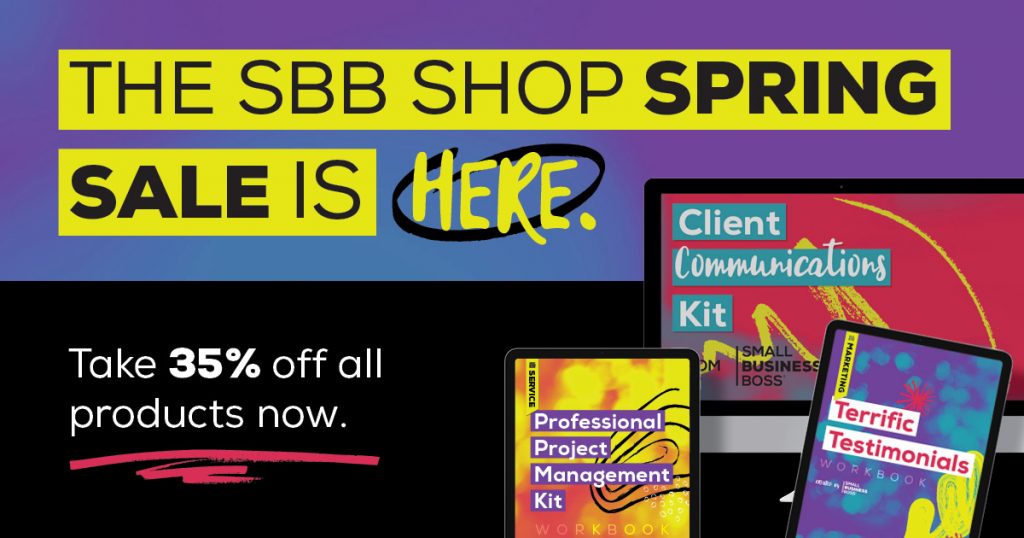

I’m Maggie Patterson (she/her), and services businesses are my business.
I have 20+ years of experience with client services, am a consultant for agency owners, creatives, and consultants, and vocal advocate for humane business practices rooted in empathy, respect, and trust.
Read or Listen to the Latest
For Solo Business Owners
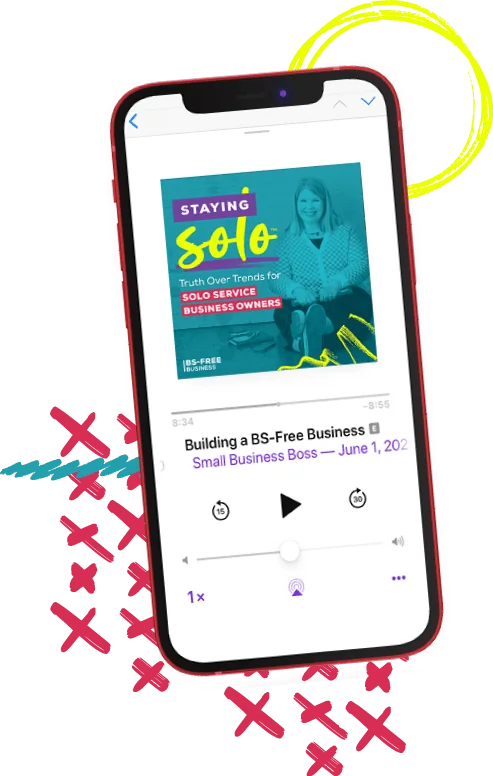
Growing a solo service business is tough.
It’s even harder when you’re bombarded with BS advice that steers you away from your values and why you started your business in the first place.
This is the podcast for solo creatives and consultants who want to remain as a team of one and have zero interest in the hustle and grind of typical business teachings.
Subscribe now and never miss an episode.
For Micro Agency Owners
Most podcasts for agency owners obsess over revenue growth as the ultimate success metric.
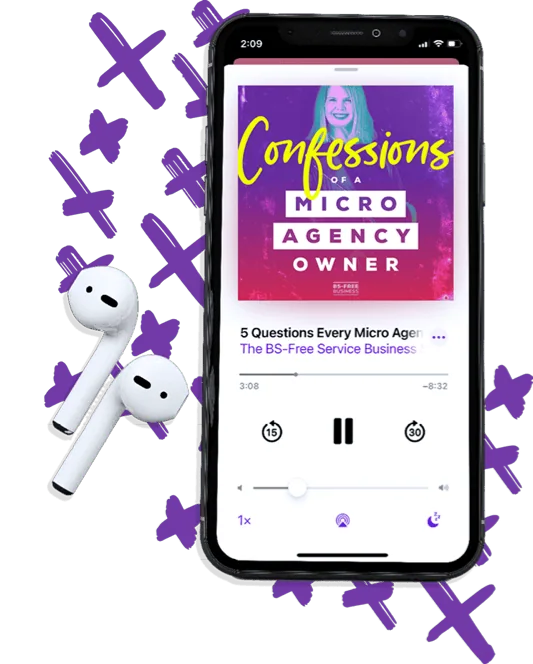
But here’s the truth: not everyone wants to make millions. Your goal might be to build a sustainable business that lets you have a life and doesn’t run you into the ground.
Join me as I spill my shameless confessions and share everything I’ve learned about building a micro agency that skips the BS of tired and typical agency teachings.
Follow Now on All Major Podcast Platforms
